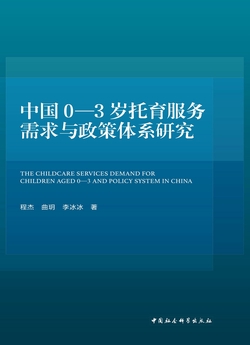
中国0—3岁托育服务需求与政策体系研究
摘要摘要:投资更大范围、更高质量的育儿照护是一个国家寻求人力资本积累和经济转型的重要战略选择,构建0—3岁婴幼儿托育服务体系是促进人口长期均衡发展、积极应对人口老龄化的重要举措。本书利用全国人口与家庭动态监测调查数据,分析中国家庭0—3岁幼儿托育服务需求特征,探讨家庭养育与生育支持政策对家庭生育意愿、生育行为、女性劳动决策与职业发展等产生的潜在影响,评估主要发达国家托育服务政策的实际效果,提出符合中国国情的0—3岁幼儿托育服务政策体系。2019年年末中国0—3岁幼儿入托率为8.26%,入托孩子年龄主要集中在两岁半以后,按照OECD的统计口径(0—36个月),目前中国幼儿入托率仅为4.29%,远低于OECD国家的平均水平。入托家庭的月入托费用占家庭月均收入比重为14.57%。现有托育服务主要依托幼儿园,专业的0—3岁托育机构发展滞后。制约托育服务发展存在供给侧和需求侧两方面因素:需求侧主要来自父母观念,认为有人照看没必要送、孩子年龄太小;供给侧主要包括孩子年龄太小机构不接受、距离太远/附近没有托育机构、收费太高。家庭选择托育机构时最关心的三个因素是安全条件、师资能力和离家距离。当前对于幼儿年龄自7个月(女性产假结束)起至3岁甚至接近4岁的近2.5—3.5年这段时间如何实现托育照料是存在制度缺失的,这样的制度缺失会影响这期间女性的就业,女性可能在近3年的时间内与劳动力市场脱节使得其难以适应新的岗位需求,进而难以再次进入劳动力市场。有效的托育制度建设可以提高女性整体的劳动参与水平,有助于提高农村户籍的外来劳动力从事生产率更高进而获得更高收入的工作,最终从劳动参与率和收入提高两个方面带来潜在的社会经济收益。对于受教育程度更高的城市户籍女性来说,能够从更完善的托育制度中减轻养育负担,进而提高就业参与率,更加充分地实现其较高的人力资本带来的收入以及对于经济社会的实际贡献。根据研究估算,全部来自托育制度释放的就业潜力(包括参与率提高以及收入提高两个方面)的实际经济贡献占当前女性总经济产出贡献的4%—6%。幼儿入托率与一国的社会福利制度、经济发展水平以及社会文化有关。经济发展水平影响托育服务供给能力,但并不是一国入托率的主要决定性因素,社会福利模式更大程度上决定了托育服务供给体系,从而影响一国的入托率。传统文化和价值观在其中扮演着根深蒂固的作用,而人口结构转变与经济转型形成了压力,通过推动公共政策改变,加快家庭托育选择方式的适应性调整。世界主要国家面向家庭的公共政策主要包括现金转移支付、服务与实物补贴、税收减免三类。政府公共投入对于促进托育服务社会化具有关键作用,家庭政策体系建设是提高入托率和入园率的重要保障。托育服务发展总体上有利于女性参与劳动力市场。托育服务的直接作用就是缓解家庭和女性在育儿照料中的压力,实现政府、社会与家庭共同承担养育责任,分担养育成本。女性从育儿照料中释放的生产力,通过参与劳动力市场发挥其价值,并作为政府和社会发挥养育功能的经济补偿。托育服务有助于降低就业率性别差异,对于促进劳动力市场性别平等具有积极意义,托育服务鼓励女性以兼职就业方式参与劳动力市场。托育服务发展的初衷之一是提高生育率,但入托率对生育率的实际作用尚不清晰。托育服务发展倾向于鼓励女性延迟生育年龄,婚外生育比例提高是托育服务发展的另一个意料之外的作用。托育服务发展不仅仅解决幼儿照料问题,同样也发挥早期教育开发的重要功能。2000年以来0—2岁平均入托率与15岁青少年PISA测试成绩呈现显著的正相关关系,入托率越高的国家,青少年阅读水平越高,数学计算能力越强,科学素养也更高,男性和女性青少年都呈现类似特征。托育服务体系应该能够基本满足各类家庭的托育需求,不同类型家庭的托育服务需求存在差异,差异体现在托育时间安排、托育方式、托育内容以及服务质量等方面。中低收入家庭的托育服务需求通过政府主导的公共托育机构或普惠性托育机构得以满足,中高收入家庭的多样化托育服务需求通过市场托育机构获得。托育机构是承担托育服务的载体,按照资源配置方式和运行机制基本上可以分为两大类:一类是政府主导的公共或准公共属性的托育机构;另一类是发展托育服务市场,按照市场化方式建设各类托育机构。托育服务发展的政策工具,按照托育服务供给方和需求方可以分为两大类:对于服务供给方的各类托育机构,重点是鼓励社会各方力量投入,刺激投资需求,扩大托育服务供给能力;对于服务需求方的各类家庭,重点是鼓励他们根据自身情况将孩子送到托育机构,在降低养育成本的同时释放家庭生产力。托育服务事业和托育服务市场的健康发展都需要一个良好的生态系统,有必要在师资力量、课程体系、行业监管、财政投入等方面强化保障机制。关键词:托育服务;女性劳动参与;生育率;人力资本积累Abstract: Investing in high quality childcare is an important strategic choice for a country s accumulation of human capital and economic transformation.The construction of childcare service system for children aged 0-3 years is an important measure to actively deal with the aging.Using the data of the national population and family dynamic monitoring survey,this study analyzes the characteristics of the demand of childcare services for children aged 0-3 years in Chinese families,discusses the potential impacts of family support policies on reproductive preferences,reproductive behavior and female employment,evaluates the practical effects of childcare service policies in major developed countries,and provides reference for the con-struction of China s childcare service system for children aged 0-3 years.At the end of 2019,China snursery attendance rate for children aged 0-3 years was 8.26%.According to the OECD s statistics(aged 0-36 months),China s nursery attendance rate is only 4.29%,which is well below the OECD national average.The cost of childcare for a family is 14.57% per cent of household income.At present,the development of China s professional nursery institutions for children aged 0-3 years lag behind.The factors restricting the development of childcare services include supply-side and demand-side:The demand side mainly comes from the parents attitude that children are too young to be sent; the supply side mainly comes from the fact that the nurseries are reluctant to accept children who are too young.At present,there is a lack of system in China s childcare services,which leads to women interrupting their occupation and facing difficulties in reentering the labor market.The childcare system can improve women s labor participation and help them achieve higher quality employment,thereby improving overall economic benefits.According to the study,the potential economic benefits of childcare account for 4 to 6 percent of women s total economic output.There are three main types of family-oriented public policies in the world s major countries: cash transfer payments,services and inkind subsidies,and tax breaks.The development of childcare servicesis generally conducive to women s participation in the labor market.The direct role of childcare services is to relieve the pressure on families and women in childcare and to realize the shared responsibility of government,society and the family for parenting.Childcare services help to reduce the gender gap in employment and play an important role in promoting gender equality in the labor market.One of the original intentions of the development of childcare services is to increase fertility,but the actual effect on total fertility rate is not clear.The development of childcare services tends to en-courage women to delay childbearing age.The development of childcare services has also played an important role in the development of early education.The average nursery attendance rate for children aged 0-2 years since 2000 was significantly positively correlated with the PISA test scores for teenager aged 15 years.In countries with higher nursery attendance rate,the higher the reading level of young people,the stronger the mathematical computing ability and the higher the sci-entific literacy.There are differences in the demand for childcare services in different types of families,mainly reflected in the timing of childcare,the way of childcare,the content of childcare and the quality of service.The demand for childcare services for lowand middleincome families is met through government-oriented public care institutions or inclusive childcare institutions,and the diversified demand for child-care services for middleand highincome families is met through market-oriented care institutions.For all kinds of care institutions on the service supply side,the emphasis is on encouraging the input of all social forces,stimulating investment demand and expanding the supply capacity of childcare services.For families on the demand side of services,the focus is on encouraging them to send their children to institutions of care,reducing the cost of parenting while freeing up family productivity.The healthy development of the childcare service and the childcare service market all need a good ecosystem,and it is necessary to strengthen the guarantee mechanism in the aspects of teach-ers,curriculum system,industry supervision and financial input.Key words:Childcare Services; Labor Force Participation Rate for Female; Total Fertility Fate; Human Capital Accumulation